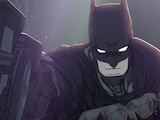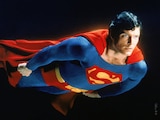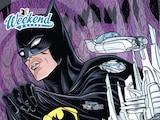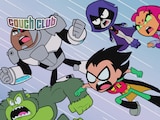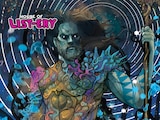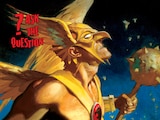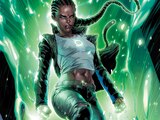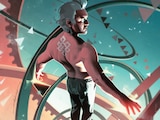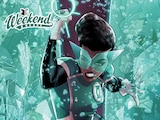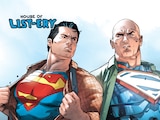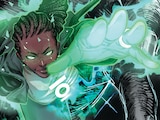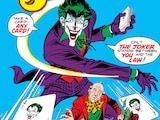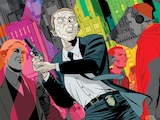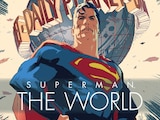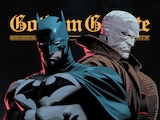It’s time once more to get some answers! Welcome to the 110th edition of ASK…THE QUESTION. I’m Alex Jaffe, better known in the DC Community as HubCityQuestion. For the past five years, I’ve disposed myself to you to help clear up any confusion or unsolved mysteries about the vast scope of the DC Universe in all its forms. For this edition, I’d like to start by clearing up some misconceptions I tend to get in my inbox about one particular character…and the reason those misconceptions happen.
How Do You Solve a Problem Like Shayera?

Wrightline1.42741 asks:
When did Hawkman and Hawkgirl’s wings go from being Nth metal harnesses to a part of their body?
MatthewHecht asks:
In Justice League Unlimited, Hawkgirl is stated to regularly beat Batman at chess. Are her chess skills DCAU only or do they exist in the comics?
Jurisdiction asks:
Has Hawkgirl ever been portrayed as a traitor to the Justice League in comics, or was that just the animated series?
There are a lot of misconceptions out there about Hawkgirl that require some clearing up. And this time, the source of the confusion isn’t any kind of snag in comic book continuity or series of reboots. When it comes to Hawkgirl confusion, the culprit is almost always the same: Bruce Timm and Paul Dini’s Justice League animated series.
When originally pitching Justice League, Hawkgirl wasn’t even included on the lineup. As a later addition to the team, Hawkgirl’s character was the one most reinvented from the ground up. This was by necessity—up until that point, nearly all Hawkgirl material which had ever been published had been predicated upon her relationship to Hawkman, and Hawkman would not be a member of this team. So, more so than any other character, Hawkgirl was entirely reimagined. Her wings became an organic part of her body—something they’ve never been and still aren’t in the comics. They gave her a new backstory and a complex relationship with a Thanagarian people who bore little in similarity to those depicted in the comics. Just as her relationship to John Stewart was a flourish invented for the show, so was her camaraderie and professional relationship with Batman—although that particular relationship would be reflected in some later comics featuring Kendra Saunders, our modern Hawkgirl, thereafter. (No chess games, though.)

Back in 2000, Bruce Timm and Paul Dini faced a similar challenge to what the current creative team behind the new Hawkgirl series faces now—without Hawkman to define her, who is Hawkgirl on her own? The answer for Kendra Saunders is as different from Shayera in the comics as it is the animated Shayera. Two different answers to the same initial question of what happens when a bird of prey flies solo.
Bruce’s Good Girls

MidknightGhost20 asks:
Was there ever a Rachel Dawes in the comics? I don’t recall Batman having a love interest who hasn’t committed any criminal acts.
Rachel Dawes, Bruce Wayne’s childhood friend and focal point of his romantic triangle with Harvey Dent in Christopher Nolan’s Dark Knight film trilogy, was an original invention of those movies. Her only comic book appearance since her debut in Batman Begins was, well, the graphic novel adaptation of Batman Begins. However, that’s not to say Bruce Wayne has never had a civilian love interest.
Back in the Golden Age, Bruce Wayne’s three most prominent love interests were Julie Madison, Linda Page and Vicki Vale. Julie Madison was already engaged to Bruce when she was introduced in Detective Comics #31 and even predates Robin as a member of Batman’s supporting cast. Oil heiress Linda Page began appearing in Bruce’s life as early as Batman #4 and was the first of Bruce’s love interests to appear outside of comics, as played by Shirley Patterson in the 1943 Batman film serial. Probably the most famous of Batman’s civilian love interests is Vicki Vale, a reporter on the hunt for Batman’s secret identity, and a relative latecomer compared to the other two, appearing first in Batman #49. Most today will recognize her from the 1989 Batman film played by Kim Basinger.

In the ’70s, Bruce dated Silver St. Cloud, an event planner who got close enough to discover his identity and left him when he couldn’t choose between his two personas. In 1987’s Batman: Year Two, Bruce falls for a young woman named Rachel Caspian, daughter of the Reaper, who would become a nun. In Batman: Knightfall, Bruce had a fling with his physical therapist, Shondra Kinsolving. In the late ’90s, Bruce dated talk show host Vesper Fairchild, until he was framed for her murder. And in the early 2000s, Bruce was briefly involved with Mallory Moxon, daughter of the crime boss Lew Moxon, who may or may not have ordered the Crime Alley hit on Bruce’s own parents.
There have been more since then, and even the occasional superhero—Bruce has shared some romantic history in the past with both Wonder Woman and Zatanna. But before Rachel, there were some serious names in Bruce’s black book that weren’t just there for show.
Reboots Are Made for Walking

BatMike-ThePunisher asks:
What major changes followed both Rebirth and Dark Nights: Death Metal?
When we think about comic book reboots, we think about them in terms of a shift in the status quo. Certain elements of ongoing stories which are suddenly changed or dialed back in their narratives to an earlier state. DC pretty much wrote the guidebook on comic book reboots, with Crisis on Infinite Earths resetting the vast majority of the DC Universe in 1986 and 2011’s New 52 doing much the same. Rebirth and Death Metal are interesting shifting points in comic book continuity, however, in that they don’t represent an alteration or even a regression, but a restoration of concepts and ideas which had been lost in previous reboots. The main conceit behind Rebirth, as first introduced in 2016’s DC Universe: Rebirth one-shot and culminating in Geoff Johns and Gary Frank’s Doomsday Clock, was a reversal of the major changes of the New 52 five years prior. With the grand changes of the New 52 revealed to be the experimental work of a multiverse-faring Doctor Manhattan, an encounter with Superman convinces him to put it all back the way it was before as best he can.
The major continuity change in Dark Nights: Death Metal is a bit more subtle, but perhaps even more ambitious. Scott Snyder and Greg Capullo referred to Death Metal, in fact, as the “Anti-Crisis,” in that it sought out to reverse not just the New 52, but every reboot and reversal of continuity. For instance, Death Metal restored the original scope of the multiverse, once again as varied and infinite as it was prior to Crisis on Infinite Earths. In its final battle between Wonder Woman and the Darkest Knight, every living person’s memories of their own history in prior iterations of continuity were unlocked, allowing future creative teams to draw on any prior status quo they chose for any character. From each hero, villain and civilian’s perspective, every story had happened to them, and every story counted. The main consequence of this is that the public is now fully aware of the existence of the multiverse, a fact that figures such as Amanda Waller are dealing with presently. Ultimately, what Rebirth and Death Metal’s consequences represent are the same thing: freedom for creators to tell the stories about the characters they love, the way they imagine.
Waiting For My Closeup

winmurray13.7468 asks:
Aquaman first appeared in More Fun Comics in 1941, but didn’t appear on the cover of a comic book until The Brave and the Bold #28 in 1960. What’s the longest gap between the first appearance of a character in the pages of a comic vs. their first appearance on a cover?
This was a difficult question to answer without creating a mental catalog of every character who has ever appeared in a comic book, but the first major prominent one who came to mind for this bill was Black Adam. Black Adam was introduced in 1945’s The Marvel Family #1, but wouldn’t be featured on a cover until 1977’s Shazam #28.
But upon further reflection, there are other characters who have him outdone. Hugo Strange, for instance, made his first appearance in 1940’s Detective Comics #36, but wouldn’t appear on a cover until 1977’s Detective Comics #471, beating the Black Adam gap by five years. But even more significant is Doctor Occult, whose first appearance in 1935’s New Fun #6 was published fifty years before his cover debut on 1985’s Who’s Who #6. If there’s anybody in the DC universe who can beat fifty years, though, I’d be happy to hear about it.
Crossing the Streams

RexRebel asks:
Who was the first DC villain from the comics to show up on film and on television? And who was the first DC villain from film and television to show up in comics?
The television ends of this four-sided question are rather straightforward, though one might have occurred later than you might otherwise have imagined. No comic book villains whatsoever appear in DC’s first television series, Adventures of Superman. But their second series, 1966’s Batman, would debut Frank Gorshin as the Riddler in its pilot episode.
But the many original villains who would also debut on that program would take much longer to break through. Not one gangster from Adventures of Superman would break through to the comics at all. Not a single original villain from Shazam, or Wonder Woman, or The Flash, or Swamp Thing, live action or animated. Not even Super Friends would invent a villain who would make it to comics. This was a media barrier which, for the 20th century, simply would not be breached.
The first breakthrough DC super-villain born from TV with enough star power that their potential reach across media could no longer be denied simply had to be none other than Harley Quinn herself; first in various print tie-ins to Batman: The Animated Series, an odd Elseworlds tale now and again, and finally debuting in mainstream comic book continuity with 2000’s one-shot, Batman: Harley Quinn.

To answer questions about early film, we’re going to have to revisit the classification of DC’s earliest filmed projects. Are the weekly serials featuring Kirk Alyn’s Superman and Lewis Wilson’s Batman considered films? What of the animated Superman shorts by Fleischer Studios in the early 1940s? I’d argue that they are, by the spirit in which they were originally screened. If your definition of film matches mine, then the answers are a little more interesting than they might be otherwise.
If we stretch our definition of film to include serials, then our answer for the first comic villain translated to film is none other than Luthor himself, in 1950’s Atom Man vs. Superman. For film to comics, you might say it’s the Mad Scientist in the very first Fleischer Superman short, who makes an appearance as a fictional character in 1942’s Superman #19 for a farcical story by Jerry Siegel and Joe Shuster themselves where Clark takes Lois out to the movies and they watch the new Superman cartoon.

However, if you’re a stickler for films being strictly defined as feature films, then we have a different set of answers. For comics to film, the first translated villains would be a four-way tie between the Joker, the Penguin, Catwoman, and once again Frank Gorshin’s Riddler in 1966’s Batman: The Movie. The other way around, the title would have to go to Lex Luthor’s put-upon assistant Miss Tessmacher, who first appeared in 1978’s Superman and broke through to print in 2000’s JLA: Earth 2.
That’s all the space we have this month, but I’ll always have time for you. Until next time, feel free to drop by my quarters in the DC Community and we’ll have a talk about whatever sector of the DC Universe troubles you. Sometimes, the key to working it all out is simply a matter of taking the initiative to ASK…THE QUESTION.
Alex Jaffe is the author of our monthly "Ask the Question" column and writes about TV, movies, comics and superhero history for DC.com. Follow him on Bluesky at @AlexJaffe and find him in the DC Community as HubCityQuestion.
NOTE: The views and opinions expressed in this feature are solely those of Alex Jaffe and do not necessarily reflect those of DC Entertainment or Warner Bros., nor should they be read as confirmation or denial of future DC plans.

